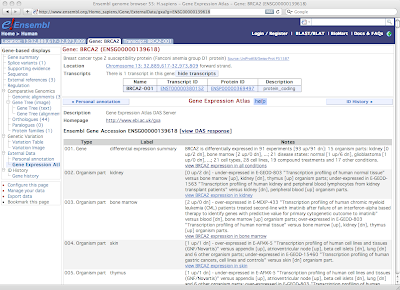Hello!
The Gene Expression Atlas now provides a DAS track that can be viewed with any number of compatible DAS clients. The most famous of these is the Ensembl Genome Browser.
Here's a screenshot of what the Atlas DAS annotations look like in Ensembl Gene View:
For every gene, the Atlas provides a brief one sentence summary of the gene's differential expression in various tissues, diseases, cell types, cell lines and other conditions. Moreover, per-condition gene activity breakdown is provided for every biological site or condition where this gene was observed. Links are provided to the Atlas gene pages.
The Gene Expression Atlas DAS is registered in the DAS Registry, where further details about it are available. For step-by-step instructions for adding Atlas annotations to your view of Ensembl, check out our Atlas DAS Help page.
We hope you find this useful. Over time we'll add more functionality to the Atlas DAS Source.
Cheers,
--Misha Kapushesky and the Atlas Team
Gene Expression Atlas Project Coordinator
Friday 18 September 2009
Monday 14 September 2009
Gene Expression Atlas 1.1.3
Hello!
We released Atlas 1.1.3 today. The main highlights of this release are:
- A collection of Atlas REST APIs
- A new Atlas DAS Track - view it in Ensembl Genome Browser
There are a number of bug-fixes, also. You can now link to genes on any number of identifiers, including synonyms and alternate names:
- http://www.ebi.ac.uk/gxa/gene/SPAC16A10.06C, for the S. pombe pli2 gene,
- http://www.ebi.ac.uk/gxa/gene/IPR001487, for Bromodomain genes, InterPro IPR001487.
Now, a little more detail on the Atlas REST APIs. These will return JSON or XML, and provide a comprehensive programmatic interface to everything you see in the Atlas Web interface. Here are some examples (lots more detail in the API documentation).
Gene and Condition Queries
These queries return gene results as in the Atlas Heatmap or List Views, with complete information on which conditions the matching genes are over/under-expressed in, including the EFO information.
- http://www.ebi.ac.uk/gxa/api?geneGotermIs=p53+binding&geneDisease=cancer
- http://www.ebi.ac.uk/gxa/api?geneIs=ASPM
- http://www.ebi.ac.uk/gxa/api?geneIsNot=cell+cycle
- http://www.ebi.ac.uk/gxa/api?geneIs=ENSMUSG0000012344
- http://www.ebi.ac.uk/gxa/api?upIn=liver
- http://www.ebi.ac.uk/gxa/api?updownInOrganismpart=heart
- http://www.ebi.ac.uk/gxa/api?downInOrganismpart=kidney&upInSex=male
- http://www.ebi.ac.uk/gxa/api?geneIs=p53&downInOrganismpart=kidney&upInSex=male
Try adding "&indent" to the end of these queries to see pretty-printed output.
Experiment Queries
These queries execute searches for experiments, either listing general experiment information, or, if one or more genes are specified, the full experiment/assay/sample relationship matrix is produced together with gene expression values and, if available, the differential expression statistics.
- http://www.ebi.ac.uk/gxa/api?experiment=cancer
- http://www.ebi.ac.uk/gxa/api?experiment=E-AFMX-5&gene=ENSG00000160766&gene=ENSG00000166337&format=xml
Again, "&indent" will pretty-print the results.
We urge you to check out the docs, try these APIs out and get back to us with feedback and requests for further functionality. We'll post here separately the instructions to enable the Gene Expression Atlas DAS Track in Ensembl. For now, here's a screenshot:

Yours,
--Misha Kapushesky and the Atlas Team
Gene Expression Atlas Project Coordinator
Subscribe to:
Posts (Atom)
